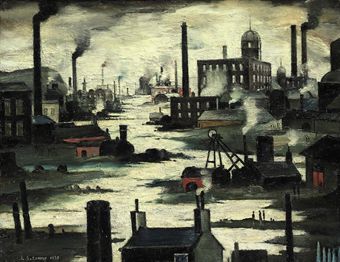Margaret’s 60th birthday followed hard on the heels of mine and, like me, I think she was viewing it with some mixed feelings (let’s be honest, no fifty-something really wants to be a sixty-something).
There was some doubt about what she might like as a gift, so I decided that we’d have a treat day. I booked the day off work and bought tickets for the Lowry exhibition at Tate Britain.
Lowry tickets were £15 each, but mine was reduced to £13.25 as I was entitled to a “senior citizen” ticket being over 60 already. There are some perks due to age!
The exhibition was a chance to see more Lowry paintings in one place than you’re likely to see anywhere and these were collected from many sources, many from the Lowry gallery in Salford.
I have always been interested in Lowry’s work and have admired his art, but I hadn’t really seen any (or so many) so close. His painting are reproduced all over the place and you’re so used to seeing them that when you get chance to view them properly, up close and personal, there are some surprises.
I didn’t know that Lowry had been heavily influenced by French impressionist painters and, indeed, studied under one in Manchester (Pierre Adolphe Valette). He exhibited his work in Paris before being shown and accepted in London or Manchester. Looking at these original paintings for the first time, I was surprised by how black and white they were. His backgrounds are almost entirely white - sky and ground. I knew they weren’t colourful, but the lack of colour was a shock. In some works, of course, he does use colour (red in particular) and this provides real impact where it’s used.
Lowry clearly set out to chronicle the industrial landscape of Lancashire, but I don’t fully understand his motivation. Was it horror at the pollution and despoilment of the environment that he wanted us to see? Was it the way people seemed to be simply a commodity in the needs of industry? Was it out of anger or out of nostalgia that he created these distinctive images? Did he want these people and their way of life to be remembered? His work seemed to become more angry as he grew older and Bargoed (below) one of a series of later, large-canvas works, depicts an horrendous industrial landscape.

I thought Lowry was a nostalgic painter, but I very much misjudged that. There are touches of nostalgia - fairs, football matches and parades - but his work mainly depicts a landscape and a people who are despoiled by industry. The fact that the industry itself is in decline and grand social schemes (such as slum clearance and the National Health Service) are clearly not solving the problems they set out to solve, simply adds to the sense of gloom.
His most famous feature is, of course, his matchstick men. These are more sophisticated than matchstick men; they are painted with form but no features and generally with little regard for perspective or scale. Other drawings show that he was a very good technical artist and yet he completely ignores scale and perspective in many paintings. Not only does he ignore it, he twists and inverts it.
Dogs are featured in almost every painting and they are dogs as I remember them from my childhood - medium-sized, short-haired black dogs; mongrels (no designer dogs) and never on a lead. Road traffic - cars and lorries - doesn’t feature very much except in a view of Piccadilly Circus in London, where traffic is the story of the artwork. Only in some pictures - the waiting room at a hospital or a man in a bombed house - do people have features and expression.
Do I like Lowry more or less after seeing this work? I think I like his work less, because now that I understand it better it is more challenging and harder to view. However, I admire it more. It has more depth and a message, but it has a gloom and depression that I hadn’t really considered. In one painting, he depicts cripples in Manchester, a grotesque but accurate image that he clearly felt compelled to record. It’s not easy viewing.
A lot of his work is very similar, he paints the same thing over and over, so his art doesn’t seem to develop, only vary in intensity. How has Bargoed moved on from River Scene (below)? Hardly at all and yet the two paintings are 30 years apart. Did his art need to develop, to move on? Perhaps only if the subject had moved on?
We were about 90 minutes inside the Lowry exhibition and we had about half an hour spare before we had to move on for lunch, so we took the chance to have a wander around the exhibition rooms in the Tate, which have been reshaped and rehung to show 500 years of British art. There was some interesting stuff and it served as a little sweet course after the bitter feast of Lowry’s paintings.
The smoke and grime of Lancashire is replaced by Constable’s Suffolk, all colour and sky. Perhaps if Constable had lived in Salford instead of Suffolk, he would have gone over to the dark side.

No comments:
Post a Comment